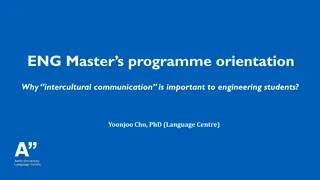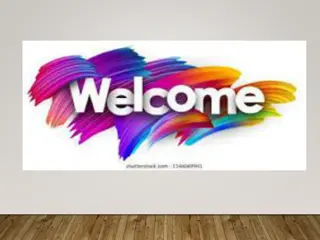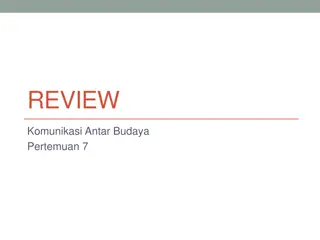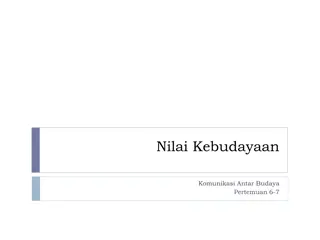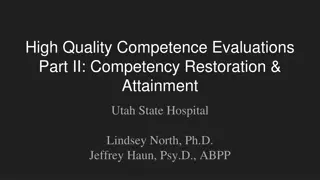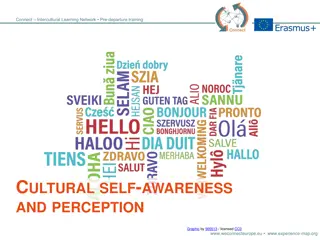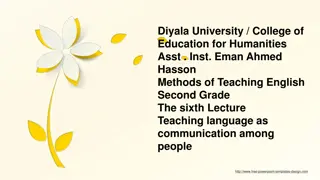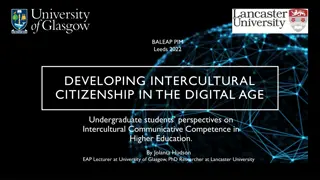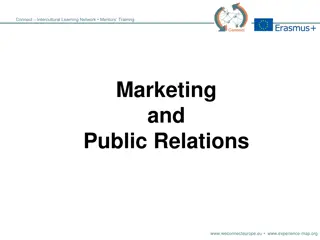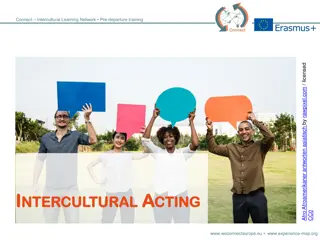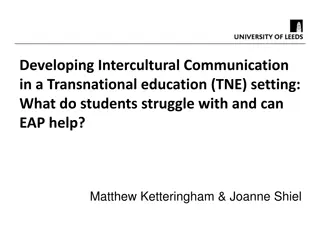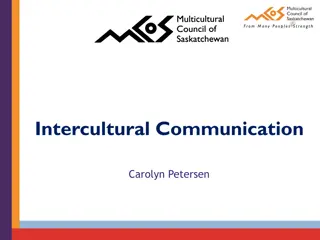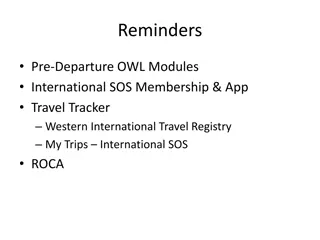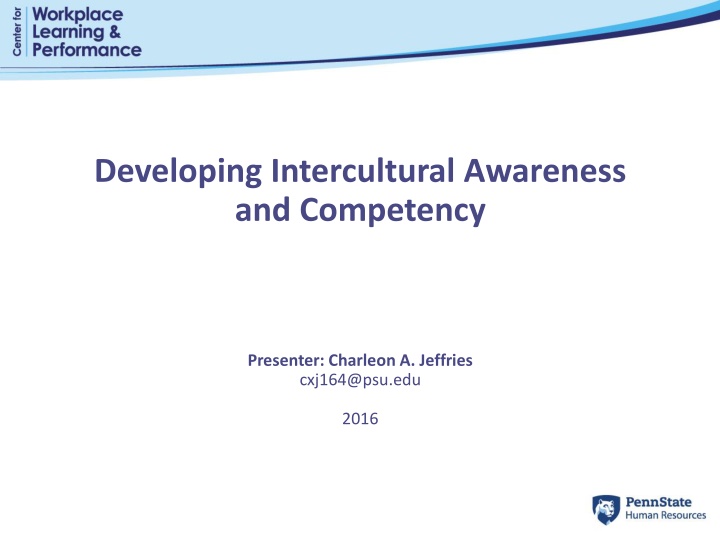
Developing Intercultural Awareness and Competency
In this session, you will learn strategies to work effectively with diverse cultures by identifying components of cultural competence, exploring intercultural differences, and enhancing awareness of personal diversity. Discover how to manage differences and foster inclusion in a multicultural environment.
Download Presentation

Please find below an Image/Link to download the presentation.
The content on the website is provided AS IS for your information and personal use only. It may not be sold, licensed, or shared on other websites without obtaining consent from the author. If you encounter any issues during the download, it is possible that the publisher has removed the file from their server.
You are allowed to download the files provided on this website for personal or commercial use, subject to the condition that they are used lawfully. All files are the property of their respective owners.
The content on the website is provided AS IS for your information and personal use only. It may not be sold, licensed, or shared on other websites without obtaining consent from the author.
E N D
Presentation Transcript
Developing Intercultural Awareness and Competency Presenter: Charleon A. Jeffries cxj164@psu.edu 2016
Welcome! Today s session will help you to develop strategies to work more effectively with those whose cultures are different from their own by: Identifying components of cultural competence. Exploring areas of intercultural difference. Developing an awareness of personal areas of difference or diversity. Growing awareness of personal styles for encountering or managing differences. Identifying strengths and areas for development around diversity and inclusion.
Culture What is culture? - Make a list of the various cultures you are a member of, or participate in. - Compile one list for the entire table - How many different cultures are represented at your table? - Are any more important/carry more significance for you?
Cultural Iceberg
Cultural Competence IS Awareness Skill Knowledge
Cultural Competence is NOT Reductionism The whole is merely the sum of its parts The whole is merely the sum of its parts Reductionism + + = +
Cultural Competence is also NOT Essentialism Essentially all [insert noun] are - - - - - Tall Leafy Strong Massive Provide Shade
Agenda Awareness Affirmative Introspection Knowledge Dimensions of Diversity Intercultural Literacy Skill Social Architecting 8
Components of Cultural Competence Knowledge Awareness Understanding of self is key in understanding how we view and interact with others. The more knowledge we have about people of different cultures, the more likely we are able to avoid stepping on cross-cultural toes. Lens? Blind Spots? Knowing how culture impacts problem solving, managing people, asking
Components of Cultural Competence Skills or Behaviors Attitude Values & beliefs impact cross- cultural effectiveness because they convey the extent to which we are open to differing values and opinions. One can have the right attitude, considerable self-awareness, and a lot of knowledge about cultural differences, yet still lack the ability to effectively manage differences. The stronger we feel about our V&B, the more likely we will react emotionally when they collide with cultural differences Skills are learned and
Affirmative Introspection Awareness We can travel the world over, but we take ourselves with us - Ralph Waldo Emerson
What is Affirmative Introspection? Knowing what makes me tick Being comfortable in my own skin Being in tune with my own biases and hot buttons
What Makes Me Tick? Experiences and messages that have shaped your values, philosophy of life & motivations behind your behaviors Knowing what makes you tick helps you to communicate more clearly who you are and why you are responding in a certain way. You expand the range of your reactions and responses for any number of situations
Whats In Your Box? Formative Experience: Importance: Impact: Feeling: Learning:
Intercultural Literacy Knowledge Nothing is either good or bad, but thinking makes it so - Shakespeare
Dimensions of Diversity Adapted from Gardenswartz & Rowe, Diverse Teams at Work: Capitalizing on the Power of Diversity, SHRM (2003).
Exploring Intercultural Values Core Cultural Values The principles or standards of importance to us that tell us how we should behave based on queues and input from our culture Values Terminal Instrumental
Mapping your Cultural Orientation Of the 8 pairs of cultural value comparisons on the slides to follow, place an X along the continuum that reflects your personal belief or orientation with those values.
Time Monochronic Polychronic Time is an unlimited good Time is a precious commodity Take the time necessary to do what is needed Time can/should not be wasted Life does not follow a clock Things will happen when they are supposed/when people arrive Careful planning to ensure you arrive at the expected time
Communication High Context/Indirect Low Context/Direct Allows space for other person to save face Might have neutral third party intervene in conflict Directness is rude/abrasive Rely on nonverbal cues Can be easily misunderstood People will extract the meaning behind the context Allows people latitude to respond and maintains harmony of the community Face-to-face conversations are important Rely on the actual words exchanged Confrontation necessary and normal Not being forthright is dishonest Cannot build trust without direct, face-to-face , honest communication
Primary Orientation Collectivist Individualist Primary importance of the group Decisions are made based on the needs of the group Consultation is key Group Harmony Identity is a function of one s group membership Personal behavior reflects on the entire group Primary importance is self May seek input from others, but ultimately personal responsibility is key Independence Mistakes reflect personally
Social Status Hierarchical Egalitarian Status differences should exist People should interact with and people should be treated each other on a level playing according to their standing field Refer to people by their titles Differences exist, but should Provides people a sense of not be used as the basis for place in the world interacting with others
Productivity Relationship Task Motivated to be constantly doing Who you are with is more something important than what you are doing What do you do? Quality of interpersonal Gatherings centered around doing something going to , playing , relationships is important Vacations include excursions and Tasks do not get in the way of explorations relationship
Conflict Maintaining Harmony Surfacing Differences All issues must be resolved Prefer to deal with matters behind the scenes No resolving conflict is to be dishonest Directness may be viewed as confrontational or threatening We can address our differences, and move forward without detriment to our working or personal relationship Not everything requires a conversation or intervention. We can have our differences and do not need to address them.
Emotional Response Restrained Expressive Emotions are a natural response to our Emotions are personal and private thoughts and feelings Physical contact may be uncomfortable Tend to have physical contact in the course of May appear to have a flat affect a conversation Reading non-verbal, emotional cues may be Generally easy to read how they are feeling difficult
Responsibility Doing Being Destiny is a matter of fate beyond our control Distrust people who believe they can control their own destiny Fate is in the hands of others (family, government, higher being) What you do in life matters Must exercise what control you have to make things happen Impatient with people who have fatalistic attitudes Not doing all you can is irresponsible
Mapping your Cultural Orientation (cont d) Once you have completed your X s, transfer your X onto the larger chart As other group members are placing their X s, on your own paper, using a star, circle, or check, place marks where you believe members of your unit might fall - -
Discussion - Where are the areas of greatest strength for your unit ? What are some potential areas for conflict? How can we mitigate or navigate through some of that conflict? - -
Social Architecting Behaviors & Skills No culture can live if it attempts to be exclusive - Mahatma Gandhi
Social Architecting Serving as a cultural interpreter Communicating effectively and resolving conflicts in diverse settings Structuring a synergistic and compelling environment
Serving as a Cultural Interpreter Understand the relationship between values and behaviors Be aware of a first reaction Consider alternate points of view suspend immediate judgment Be willing to advocate for awareness and understanding
Navigating through Cultural Differences - At your tables, select one of the value spectrums that, as a group, you d like to explore in more detail. How do you see conflict or challenges arising among the people you work with based on their differences along this spectrum? How might you help provide insight or perspective for others about these differences? What are some messages or language you could use to help others navigate this difference? - - -
Communicating Through Conflict One size does NOT fit all Culture and diversity brings variation to communication styles in multiple ways Style Content Non-Verbals What works for you vs What works for others
Closing Thoughts Awareness Affirmative Introspection You start with your lens Knowledge Intercultural Literacy What do I know about other-ness What do I need/want to know Behaviors/Skills Social Architecting Bringing people together
Questions? Charleon A. Jeffries Coordinator, Diversity Education Affirmative Action Office 328 Boucke Bldg (814) 863-0471 cxj164@psu.edu


